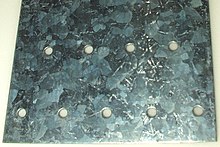In the most common use of the word, this means electrochemical oxidation of metals in reaction with an oxidant such as oxygen. Rusting, the formation of iron oxides, is a well-known example of electrochemical corrosion. This type of damage typically produces oxide(s) or salt(s) of the original metal. Corrosion can also occur in materials other than metals, such as ceramics or polymers,
although in this context, the term degradation is more common.
Corrosion degrades the useful properties of materials and structures
including strength, appearance and permeability to liquids and gases.
Plating, painting, and the application of enamel are the most common anti-corrosion
treatments. They work by providing a barrier of corrosion-resistant
material between the damaging environment and the structural material.
Aside from cosmetic and manufacturing issues, there are tradeoffs in
mechanical flexibility versus resistance to abrasion and high
temperature. Platings usually fail only in small sections, and if the
plating is more noble than the substrate (for example, chromium on
steel), a galvanic couple will cause any exposed area to corrode much
more rapidly than an unplated surface would. For this reason, it is
often wise to plate with active metal such as zinc or cadmium. Painting
either by roller or brush is more desirable for tight spaces; spray
would be better for larger coating areas such as steel decks and
waterfront applications. Flexible polyurethane coatings, like
Durabak-M26 for example, can provide an anti-corrosive seal with a
highly durable slip resistant membrane. Painted coatings are relatively
easy to apply and have fast drying times although temperature and
humidity may cause dry times to vary.
 Aluminium alloys often undergo a surface treatment. Electrochemical
conditions in the bath are carefully adjusted so that uniform pores
several nanometers
wide appear in the metal's oxide film. These pores allow the oxide to
grow much thicker than passivating conditions would allow. At the end of
the treatment, the pores are allowed to seal, forming a
harder-than-usual surface layer. If this coating is scratched, normal
passivation processes take over to protect the damaged area.
Aluminium alloys often undergo a surface treatment. Electrochemical
conditions in the bath are carefully adjusted so that uniform pores
several nanometers
wide appear in the metal's oxide film. These pores allow the oxide to
grow much thicker than passivating conditions would allow. At the end of
the treatment, the pores are allowed to seal, forming a
harder-than-usual surface layer. If this coating is scratched, normal
passivation processes take over to protect the damaged area.
Anodizing is very resilient to weathering and corrosion, so it is commonly used for building facades and other areas that the surface will come into regular contact with the elements. Whilst being resilient, it must be cleaned frequently. If left without cleaning, panel edge staining will naturally occur.
source: http://en.wikipedia.org/wiki/Corrosion
Corrosion removal
Often it is possible to chemically remove the products of corrosion. For example [phosphoric acid] in the form of [naval jelly] is often applied to ferrous tools or surfaces to remove rust. Corrosion removal should not be confused with electropolishing, which removes some layers of the underlying metal to make a smooth surface. For example, phosphoric acid may also be used to electropolish copper but it does this by removing copper, not the products of copper corrosion.Resistance to corrosion
Some metals are more intrinsically resistant to corrosion than others (for some examples, see galvanic series). There are various ways of protecting metals from corrosion including painting, hot dip galvanizing, and combinations of these.Protection from corrosion
Surface treatments
Applied coatings
Main article: Galvanization
Galvanized surface
Reactive coatings
If the environment is controlled (especially in recirculating systems), corrosion inhibitors can often be added to it. These form an electrically insulating or chemically impermeable coating on exposed metal surfaces, to suppress electrochemical reactions. Such methods obviously make the system less sensitive to scratches or defects in the coating, since extra inhibitors can be made available wherever metal becomes exposed. Chemicals that inhibit corrosion include some of the salts in hard water (Roman water systems are famous for their mineral deposits), chromates, phosphates, polyaniline, other conducting polymers and a wide range of specially-designed chemicals that resemble surfactants (i.e. long-chain organic molecules with ionic end groups).Anodization
Main article: Anodizing

This climbing descender is anodized with a yellow finish.
Anodizing is very resilient to weathering and corrosion, so it is commonly used for building facades and other areas that the surface will come into regular contact with the elements. Whilst being resilient, it must be cleaned frequently. If left without cleaning, panel edge staining will naturally occur.
source: http://en.wikipedia.org/wiki/Corrosion



No comments:
Post a Comment